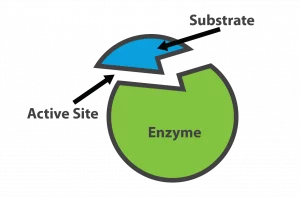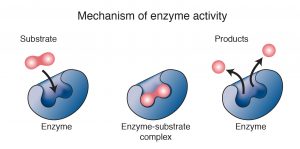What are Enzymes? – Definition, Classification, Function
Introduction to Enzymes
Enzymes are fascinating molecules that play a crucial role in various biological processes. From aiding digestion to facilitating DNA replication, enzymes are involved in numerous biochemical reactions within the body. In this article, we will delve into the world of enzymes, exploring their definition, structure, classification, function, mechanism, and more.
What are Enzymes?
Enzymes are specialized proteins that act as biological catalysts. Simply put, they speed up chemical reactions without being consumed or altered in the process. These efficient catalysts enable essential biochemical reactions to occur at a rate that sustains life. Without enzymes, many vital processes within the body would be too slow to sustain life as we know it.
Looks tough? Let’s understand the concept of enzyme in another way,

Enzyme Definition
Enzymes are like the superheroes of the biological world. They are special proteins that act as catalysts, speeding up chemical reactions that are essential for life. Enzymes are involved in a wide range of processes within living organisms, including digestion, energy production, and DNA replication. Without enzymes, many of these vital processes would be too slow to sustain life.
Structure of Enzyme
Enzymes have a unique structure that enables them to perform their functions effectively. They are typically made up of long chains of amino acids, which fold into complex three-dimensional shapes. This unique structure is crucial because it allows enzymes to interact with specific molecules, known as substrates, and facilitate chemical reactions. Imagine enzymes as locks that only certain keys (substrates) can fit into.
Enzyme Examples
Enzymes exhibit remarkable versatility and can be found in various biological systems. Here are a few examples of enzymes and their roles:
Examples of Enzymes
- Amylase: Found in saliva and pancreatic secretions, amylase breaks down complex carbohydrates into simple sugars during digestion.
- DNA polymerase: This enzyme is essential for DNA replication, as it synthesizes new DNA strands by adding nucleotides to the existing template strands.
- Catalase: Present in nearly all living organisms, catalase converts hydrogen peroxide into water and oxygen, preventing cellular damage caused by this reactive molecule.
- Proteolytic Enzymes: These enzymes are involved in breaking down proteins into smaller components. One well-known proteolytic enzyme is pepsin, which helps with protein digestion in the stomach.
- Liver Enzymes: Liver enzymes like ALT and AST are essential for detoxifying the body and metabolizing drugs and nutrients.
- Cardiac Enzymes: Cardiac enzymes like Troponin are used to diagnose heart-related conditions, such as heart attacks.
- Pancreatic Enzymes: The pancreas produces enzymes like amylase, lipase, and protease, which play a vital role in digesting carbohydrates, fats, and proteins.
- Hydrolytic Enzymes: These enzymes assist in breaking down substances through hydrolysis, which is the addition of water molecules. An example is lipase, which helps digest fats.
These examples illustrate the diverse functions that enzymes fulfill in biological systems.
Classification of Enzymes
Enzymes can be classified based on several criteria. Let’s explore some common categories of enzymes:
- Oxidoreductases: These enzymes are involved in oxidation-reduction reactions, where electrons are transferred between molecules. They play a vital role in cellular respiration, where energy is produced.
- Transferases: Transferases catalyze the transfer of functional groups from one molecule to another. An example is the enzyme hexokinase, which is involved in the first step of glucose metabolism.
- Hydrolases: Hydrolases break chemical bonds through the addition of water molecules, often involved in digestion and intracellular processes.
- Lyases: Lyases cleave chemical bonds without the addition of water or the transfer of electrons, resulting in the formation of new double bonds or the introduction of functional groups.
- Isomerases: Isomerases catalyze the rearrangement of molecules, converting one isomer into another.
- Ligases: Ligases join two molecules together, using the energy from ATP hydrolysis.
This enzyme classification helps categorize enzymes based on their specific functions and the types of reactions they facilitate.
Functions of Enzyme
Enzymes perform a wide range of functions, each essential to the overall functioning of living organisms. Some common functions include:
- Metabolism regulation: Enzymes regulate metabolic pathways by controlling the rate and direction of biochemical reactions.
- Digestion: Enzymes such as amylase, protease, and lipase break down food molecules into smaller, more readily absorbable components.
- DNA replication and repair: Enzymes like DNA polymerase and DNA ligase ensure accurate replication and repair of DNA molecules.
- Defense mechanisms: Enzymes such as lysozyme help defend the body against bacterial and fungal infections.
- Cellular signaling: Enzymes participate in cell signaling pathways, mediating various intracellular signals and responses.
Hence these are a few functions of enzymes, and these functions highlight the vital role enzymes play in maintaining the intricate balance of biochemical processes within the body.

Enzymes Mechanism
To understand the mechanism of enzymatic reactions, let’s explore the process in detail:
- Initiation: The enzymatic reaction begins when the substrate collides with the active site of the enzyme. This collision induces a conformational change in the enzyme, enhancing its binding affinity for the substrate.
- Transition state formation: As the substrate binds to the enzyme’s active site, it undergoes a transition state—a high-energy, unstable state where the reaction is most likely to occur.
- Catalysis: The enzyme stabilizes the transition state, lowering the activation energy required for the reaction to proceed. This makes the reaction faster and more efficient.
- Product formation: The reaction reaches completion, resulting in the formation of products. The enzyme then releases the products and is free to bind to other substrates, continuing the catalytic cycle.
Understanding this mechanism provides insights into how enzymes enable biological reactions to occur rapidly and efficiently.
Enzyme-Substrate Interactions
Enzyme-substrate interactions are crucial for the catalytic activity of enzymes. The specificity of these interactions allows enzymes to selectively bind to their respective substrates. This specificity arises from complementary shapes and chemical properties between the active site of the enzyme and the substrate. The binding of the substrate to the enzyme’s active site induces conformational changes that bring the reactants into ideal positions for the reaction to occur.
Enzyme Reactions
Enzyme reactions occur within the context of larger biochemical pathways. Understanding these reactions provides insights into the intricate web of metabolic processes that enable life. Enzymes participate in highly regulated, interdependent reactions, ensuring the efficient flow of molecules through metabolic pathways.
Enzyme Actions
Enzyme actions can be described through various equations, representing the biochemical reactions they facilitate. Here are a few examples:
Enzyme-catalyzed reaction: A + B → C + D
Enzyme-substrate complex formation: E + S ⇌ ES → E + P
Competitive inhibition: I (inhibitor) + E (enzyme) ⇌ EI
Allosteric regulation: E (enzyme) ⇌ E-activated state
These equations provide a glimpse into the different types of enzymatic actions and the underlying chemical processes.
Factors Effect Enzyme Actions
Several factors influence the actions of enzymes. Here are three important ones:
- Temperature: Enzyme activity is highly dependent on temperature, with an optimal temperature range for each enzyme. Extreme temperatures can denature enzymes, rendering them ineffective.
- pH: Enzymes also have an ideal pH range for optimal activity. Deviations from this range can alter the enzyme’s structure and impair its catalytic function.
- Substrate concentration: The rate of enzymatic reactions often increases with increasing substrate concentration. However, there comes a point where the enzyme becomes saturated, resulting in no further increase in reaction rate.
By understanding these factors of enzymes, scientists can fine-tune experimental conditions to maximize enzyme activity or explore enzyme kinetics.
Conclusion
Enzymes truly are remarkable catalysts that drive essential biochemical reactions within living organisms. From the structure and classification to the mechanism and functions, we have explored various aspects of enzymes in this article. Understanding enzymes is not only crucial in scientific research but also in appreciating the fascinating complexity of the natural world.
Remember, enzymes are the workhorses of biology, tirelessly facilitating countless reactions that sustain life. As we continue to unravel the intricacies of enzymatic actions, our appreciation for these remarkable catalysts grows. So, the next time you enjoy a delicious meal or marvel at the wonders of DNA replication, take a moment to appreciate the underlying enzymatic magic that makes it all possible.
This is all about Enzymes as well we have given the enzyme classification and enzyme mechanism. Enzyme reactions in detail. If you’d like to further your comprehension of related topics in a clear and concise manner, you can explore our Tutoroot blog section. If you’re looking for exceptional online tutoring to boost your academic achievements, Tutoroot is your best option. Click here to schedule a FREE DEMO session with our highly qualified educators.
FAQ’s
Q: What is the function of digestive enzymes?
Digestive enzymes play a crucial role in breaking down complex food molecules into smaller, more easily digestible components. For example, amylase aids in the breakdown of carbohydrates, protease facilitates the digestion of proteins, and lipase assists in the breakdown of lipids. These enzymes enhance the efficiency of digestion and nutrient absorption in the intestines.
Q: What are the properties of enzymes?
Enzymes possess several key properties, including:
- Specificity: Enzymes exhibit high specificity for their respective substrates, allowing them to selectively bind and catalyze specific reactions.
- Efficiency: Enzymes dramatically increase the rate of reactions, making biochemical processes feasible within a reasonable timescale.
- Regulation: Enzymes can be regulated through various mechanisms, enabling precise control over metabolic pathways.
- Reusability: Enzymes can undergo multiple catalytic cycles, making them highly efficient and environmentally friendly catalysts.
These properties contribute to the essential role enzymes play in biochemical processes.
